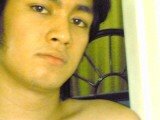"ANG KRISTO: PASYON-DULA", BUENAVISTA, MARINDUQUE ABRIL 12 & 13, 2006
MGA TALA NG MANUNULAT AT DIREKTOR TUNGKOL SA DULA:
‘SINAKULO’
“Sinakulo” ang tawag sa alin mang pang-Mahal na Araw na dula tungkol sa kalbaryo ng Panginoong HesuKristo. Karaniwang sinisimulan ito sa Banal na Hapunan (“senakulo” ang turing sa silid na pinagdausan ng ‘Huling Hapunan’ ni HesuKristo at mga apostoles ayon sa ‘Pasyong Mahal’) at natatapos sa ‘Pagkabuhay Muli’.
Tila laging bantulot naman ang mga kritiko ng sining na ihanay sa tinataguriang lehitimong teatro ang ‘Sinakulo’ tulad ng noo’y ‘Zarzuela’ at ‘Moro-moro’ at modernong teatro ngayon dahil diumano sa ‘kapayakan’ ng mga ito. Ibang pamamaraan at pamantayang estetiko raw ang ginagamit sa mga ito na higit na umaasa sa mga ‘payak’ na personal o pinaghalong interpretasyon ng mga gumaganap bilang tauhan at mga namamahala ng ‘Sinakulo’.
Naroong makita natin, halimbawa, na para makilala ng mga manonood si San Pedro ay kailangang may dala itong panabong dahil itinatwa nito si Hesus ng tatlong beses bago tumilaok ang manok, sa iba naman ay kailangang may hawak na susi ng lanngit.
Bagama’t ang lihim na pag-iibigan nina Claudia at Longhino tulad ng sa ilang lugar ay hindi maaring sabihing ‘payak’ kung ang basehan ay kaisipan ng sumulat nito na inimport pa nga naman. At lalong hindi masasabing ‘payak’ kung libo-libong piso (o milyon-milyong piso kaya), ang ginagasta para sa pagpapatayo ng palasyo ni Pontio Pilato na ang disenyo ay tipong Disneyland o ‘Camelot’. Subalit ‘Sinakulo’ pa rin ang mapuwersang turing ng lahat sa mga ito. At ‘senakulistas’ naman ang tawag ng mga gumaganap sa kanilang sarili, gayundin ang tawag ng mga manonood..
“ANG KRISTO: PASYON-DULA”
Ano’t ano man iyon, nagkaroon ng pagkakataong mabuo ang “ANG KRISTO: PASYON-DULA” sa bayan ng Buenavista, Marinduque ngayong taong 2006.
Sa mga kadahilanang nabanggit na, hindi nga ito ‘Sinakulo’. ‘Passion Plays’ ang tawag sa Ingles sa mga dulang naglalarawan sa buhay at pasakit ni HesuKristo, mula sa Oberammergau (Alemanya), hanggang sa Estados Unidos na kung saan ito itinatanghal at dinarayo upang panoorin. Kaya’t bago ito tawaging ‘Sinakulo’ ay maiging idikit na ng maaga ang salitang “Pasyon-Dula” sa titulo ng “ANG KRISTO”. Nang may kasimplehan o ‘kapayakan’. Ang tawag sa kabuuhan ng gawain mula pag-iisip, pananaliksik, pag-eensayo, hanggang sa pagtatanghal ay simple rin: Pasyon-Dulaan.
Ang kaibahan nga lamang, upang higit na maunawaan ng mga manonood ng pasyon-dulang ito kung saan nagmula ang mga pangyayaring naging kadahilanan sa pagpako sa Krus at pagkamatay ng Panginoong HesuKristo, na hindi maaaring makita kung ang dula ay sisimulan sa Huling Hapunan, kinailangang simulan ang kuwento mula sa pagbautismo kay Hesus ni Juan Bautista at ipakita ang mga mahahalagang pangyayari ayon sa kuwento ng buhay Niya mula ng panahong iyon.
Ang mga mahahalagang pangyayaring ito ang binigyang buhay sa unang bahagi ng dula. Kaya’t ang ikalawang bahagi ay magsisimula naman sa pagsalubong sa Kanya sa Herusalem.
Kinailangan ang masusing pananaliksik.

s
Ginamit ang ‘Magandang Balita Biblia’, King James Version ng Biblia, ‘Kasaysayan ni Longhino’ (Eli Obligacion, dulang itinanghal sa Gasan, Marinduque 1997),’Gospel of Luke’ (Catholic Pastoral Edition), ‘The Lost Teachings of Jesus’ (Summit Univ. Press),’The Story of Redemption’(Ellen White), ’Pasion ni Hesukristo’ (Mariano Pilapil), ‘The Life of St. Longinus’ (Caxton’s English Text), ‘Detached Account of Longinus (Emmerich), ‘Detached Account of Abenadar’ (Emmerich), Internet search finds tungkol kay Claudia Procula, Longinus, Pontius Pilate.
Pinanggalingan din ng ilang materyal ang mga pelikulang “The Passion of the Christ”, “Jesus Christ Superstar”, ”Jesus of Nazareth”, “Jesus”. Ang mga teksto sa iskrip na may kaukulang marka ay direkta o halos direktang hinango sa ‘Magandang Balita Biblia’.
PAGBUBUO AT DIWA NG BOLUNTERISMO
Natapos ang unang balangkas ng iskrip noong Pebrero 24, 2006. Nagsimulang mamili ng mga magsisiganap sa dula noong Marso 4, 2006, at sinimulan kaagad ang pag-eensayo bagama’t wala pang kaliwanagan kung paano magkakalap o saan manggagaling ang pondong gagastusin sa ganito kalaking produksiyon. (Higit sa 60 ang kailangang magsisiganap). Subali’t tulad ng paulit-ulit naming sinasabi sa mga artistang tumugon sa panawagan, ang ano mang mabuting bagay o magandang panaginip ay hindi mawawalan ng tagasuporta at lahat ay matutugunan – kung may pananampalataya sila sa buti ng kanilang ginagawa.
Sumaklolo na nga ang Pamahalaang Bayan ng Buenavista sa pangunguna ni Mayor Madrigal at kanyang mabubuting mga kaibigan. Gayundin ang mga kaibigan ng Balangaw. Sumuporta ang mga magulang ng mga kabataang kasali (mga mag-aaral at mga out-of-school youths), na nakaunawa na maaaring gabihin sa pag-uwi ang kanilang mga anak sa pag-eensayo. Nagbigay ng suportang moral ang DepEd sa pagsali ng ilang mga guro.
Ang lahat ng may kinalaman sa pagbuo ng dula ay maagang tinanggap sa kanilang sarili na ang pangyayaring ito ay sinasalihan ng bawa’t isa sa Diwa ng Bolunterismo at hangad na maging bahagi ng pagpapayabong ng sining at kultura (o pag-unlad ng turismo man), sa magandang Buenavista. At sa pagsasagawa nito ay maging bahagi ng paghugis ng modernong pangkulturang kasaysayan ng kanilang stariling bayan at komunidad. Iyon lamang!
TAMPOK NA MGA TAGPO
Bangungot ng isang mandudula na sumulat ng isang drama na di naman maiisagawa sa ibat-ibang kadahilanan, mga limitasyon. Subalit depende na nga iyon sa pagkamalikhain ninuman. Sa kaso ng “Ang Kristo”, base sa ipinamalas na kakayahan ng mga artistang gumaganap ay nadagdagan pa ang unang balangkas nito at sa huli ay naisakatuparan ang mga sumusunod na eksena sa loob ng limang linggong pag-eensayo:
UNANG YUGTO “MESIYAS”
1. PAGBAUTISMO KAY JESUS
2. PANUNUKSO NI SATANAS
3. PROKLAMASYON NG MISYON NI HESUS SA NAZARETH
4. MGA PANGARAL NI JESUS / PAGPAPAGALING
5. SI MARIA MAGDALENA
6. SA TANIMAN NG MAIS / ISYU NG SABADO
7. JUAN BAUTISTA IPINABILANGGO!
8. BEELZEBUL
9. BABAENG NAHULI SA PAKIKIAPID
10. “MALAKAS ANG DATING NG JESUS NA ITO!” (MGA KRITIKO)
11. PAGPILI SA LABINDALAWA / BEATITUDES
12. GALIT ANG DIYABLO
13. BABAENG MAKASALANAN SA BAHAY NG PARISEO
14. TRANSFIGURATION
15. ANG TAONG GRASA
16. BUKAS AT WALANG TAKOT NA PAHAYAG NI HESUS
17. SENTIMYENTO NG MGA APOSTOLES
18. SI LAZARO
19. HERODES (DECADENCE)
IKALAWANG YUGTO “KRISTO”
1. MGA KETONGIN
2. PAGPASOK SA JERUSALEM
3. ANG GALIT NA KRISTO
4. KRISTO / MAGDALENA/ APOSTOLES
5. PAGHUHUGAS NG MGA PAA / BANAL NA HAPUNAN
6. GETHSEMANE AT PAGDAKIP KAY KRISTO
7. SANHEDRIN (CAIPHAS, ANNAS, ESCRIBAS, PARISEOS, JUDAS
8. SA HARAP NI PILATO / PAGKAMATAY NI JUDAS
9. HERODES
10. PAGBALIK KAY PILATO
11. PAGHAGUPIT / PAGLIBAK / BARABAS /PAGHUGAS KAMAY
12. PANAGINIP NI CLAUDIA PROCULA
13. PAGTATALO NI PILATO AT CLAUDIA
14. VIA CRUCIS HANGGANG SA PAGLIBING (At mga Piling Salita ni HESUKRISTO) - Pagkadapa; mga kababaihang nanangis; mga Apostol; Maria (Ina), Magdalena, Juan, Veronica, Simon ng Cyrene, kilos ng mga Pariseos, mga Kawal, mga mamamayan, Pagpako, Pagkamatay, Libing.
15. PATOTOO NI LONGHINO / HIMAGSIK NG BUDHI NI PILATO
16. ANG PAGKABUHAY NA MULI NI KRISTO/
PAGPAPAKITA NI KRISTO SA MGA APOSTOLES
PRODUKSIYON
Minabuting period costumes ang idisenyo na sinaliksik ni Ian Sotto ng Escolta. Mga katutubong materyales at disenyo naman para sa props at entablado na dinisenyo ni Alvin Ereso ng Caigangan. May karanasan siya sa ganitong gawain sa mga pang-komersiyal na tanghalan sa Maynila. Si Bobby Labay ng Pinggan ang nagplano ng pang-ilaw na disenyo dahil naging lightsman naman siya sa CCP noong araw. May kaalaman din siya sa paggawa ng fog machine na dry ice ang gamit para sa ilang eksena.
Ang karamihan sa nagsiganap ay sa kabayanan ng Buenavista nakatira. Ang ilan nama’y mga taga Caigangan, Bancoro, Bagtingon, Malbog, Libas, Yook, Antipolo at Lipata. Ang ilan ay hatid ni Ian pag-uwi sa kanyang tricycle.
Wala sa orihinal na plano ang mag-anyaya ng mga panauhing artista (dulaan o pelikula), subalit nabuksan ang pagkakataong makasalamuha naman ng mga kabataang artista ang isa sa kanilang mga hinahangaan na kahaliling gaganap bilang Kristo.
PANANALIG
Sa huli, maliwanag na ang “ANG KRISTO: PASYON-DULA “ ay isang buhay na patotoo na “anuman ang hingin natin sa panalangin, manalig tayong natanggap na natin iyon at matatanggap nga natin!” (Mc 11:24). Amen!
.jpg)
.jpg)






